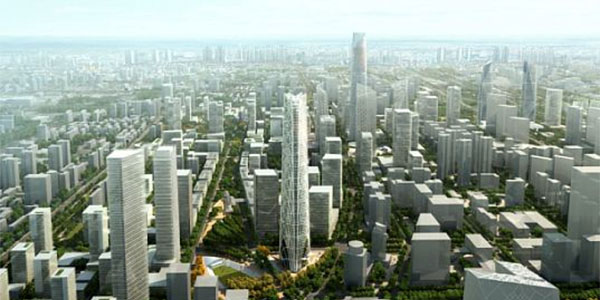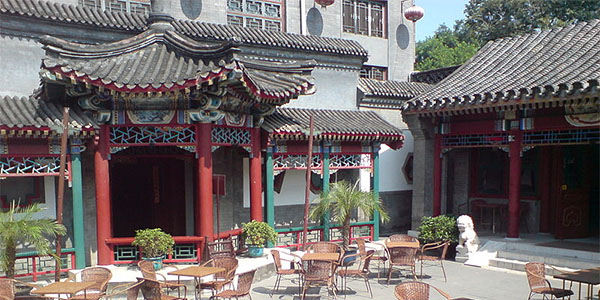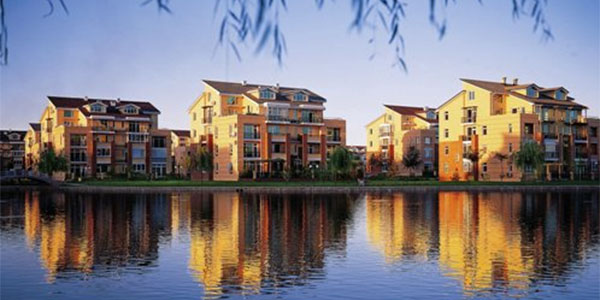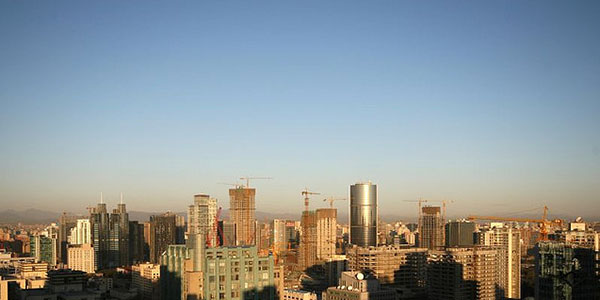Doubtless one of the more daunting tasks in planning a move to Beijing is that of finding Beijing housing. How do you even know where to begin?

You're relocating to an unfamiliar city and country, don't speak, read, or write the language, and hardly know anyone there... and if that wasn't enough, you're not even sure what kind of housing exactly you should be looking for, what area you want to put down roots in, and what kind of prices you're looking at for your new home.
There's a lot to decide and a lot more to figure out. Fortunately, you're neither flying blind nor solo - I'm here to help you through the process of finding and selecting your new housing in Beijing, every step of the way.
We'll review three things in this article:
- The 4 Kinds of Beijing Housing
- The Major Expatriate Housing Areas
- The Cost of Housing in Beijing
Let's begin by going through your options on the kind of housing available for your selection.
Beijing Housing: The 4 Different Flavors
Housing in Beijing comes in four distinct flavors or varieties. They are:
- Villas
- Apartments
- Serviced Apartments
- Courtyards (Siheyuan)
Let's have a look at each.
-
Villas can range from townhouses to larger-sized homes, and are predominantly located in the suburbs of Beijing. The majority of Beijing expatriate residents reside in Beijing's Shunyi suburb, between the airport and city, about an hour outside of town by car.
Villas tend to be concentrated inside of villa community complexes, frequently replete with amenities such as parks, swimming pools, and gyms, and situated nearby to international schools and Western grocery stores, shopping, and restaurants.
You'll find that villas are often perfect for families, providing safer, quieter surroundings with less traffic and more open space. The biggest drawback to living in a villa is the majority's distance from downtown - though this isn't a big deal if you're not spending much time in the city itself, or if you don't mind a bit of a commute.
-
Apartments are the bread-and-butter of the Beijing housing experience, for practical reasons: a city as dense as Beijing simply doesn't have the space for all that many larger residences (like villas).
Chances are that when you first come to Beijing, you'll be living in an apartment. Apartments are available throughout the city, although prices and condition vary; you can find very inexpensive apartments, though they'll often be somewhat far removed from the city center and are nothing like what you'd expect out of even an inexpensive Western apartment (e.g., dirty, poorly maintained, no Western shower and often no Western toilet, very hard beds, etc.), and you can find luxury apartments to match the fixtures and amenities of the finest apartments in any other city in the world. It all depends on what you're looking for.
For a comprehensive guide on finding your own apartment, see our article here: How to Find a Beijing Apartment.
-
Serviced Apartments are a type of apartment that is managed somewhere in between a standard apartment and a hotel room. You won't have to worry about water, electricity, cable, Internet, or other utilities; and housekeeping services will tidy up the premises once a week or sometimes even more often. There's often someone sitting down at the front desk of the building, ready to assist you with maintenance or other problems if you call down or visit.
Serviced apartments are still treated the same as standard apartments in that you'll have to sign a lease and make a deposit (typically equal to one month's rent). There are several varieties of serviced apartment: the standard variety, which requires leases of 30 days or more, and corporate housing, which accepts shorter term stays but charges higher fees.
-
Courtyards (or Siheyuan) are Chinese traditional housing that are popular as both residences and hotels with foreigners searching for a more historical Chinese experience than that offered by modern apartments or Western-style villa communities. The siheyuan style of building dates back over 2,000 years, and was common right up until the 1990s in Beijing, when these primarily single-story buildings began to be demolished en masse to make way for far more practical multi-story apartment buildings that could house more of Beijing's rapidly increasing population.

Many of the remaining siheyuan
have been renovated, modernized, and brought into the 21st century.
Often considered luxury residences, these redesigned and Westernized
siheyuan fetch anywhere from ¥20,000 per month in rent at the lower end
to ¥100,000+ monthly at the higher... numbers that would shock the
migrant Chinese living in the remaining un-modernized siheyuan at rent
prices equaling roughly one one hundredth of those charged to
inhabitants of the renovated variety.
The housing option you choose of course is going to depend on your preferences, work situation, and family situation. For instance, you won't find many singles living in villas out in the suburbs... just like you won't find many families with apartments in the middle of Sanlitun (the city's shopping, dining, and nightlife center in downtown).
Apartments will be your least expensive option, most of the time; villas and courtyards your most. Serviced apartments are typically a few thousand renminbi more than per month than identical unserviced apartments, although the savings you get in time and hassle often more than make up for the difference.
Selecting Your Area: Where Will You Live?
Expatriates living in Beijing tend to settle into one of the following areas:
-
Central Business District (北京商务中心区): Beijing's Central Business District, or CBD, is home to many multinational business's China headquarters and is a popular place for professionally employed expatriates to put down roots. The CBD hosts offices of 117 of the Fortune 500 businesses. In addition to finance, media, and business services, there are a variety of shopping, restaurant, hotel, and nightlife options in the CBD as well.
-
Chaoyang Park (朝阳公园): think of Chaoyang Park as a more centrally-located take on the northeast's Lido. A popular residential area for expatriates, Chaoyang Park offers plenty of activities, international schools, nightlife, and employment (with many corporate offices located here). The actual Park itself is largely, verdant, and beautiful - a green, tranquil escape within the confines of overwhelmingly dense and gray Beijing.
-
Shuangjing (双井街道): Shuangjing is the recently constructed overflow residential area for Beijing's CBD. Once the CBD was largely built, but demand for housing in the area continued to skyrocket, development began in Shuangjing, transforming it into a popular residential area for expatriates. Shuangjing is home to an artistic scene, and features a number of new small Western-style bars, cafés, and lounges operated by expatriates or Westernized Chinese.
-
Sanlitun (三里屯): formerly the home to the embassies of other nations throughout the world, Sanlitun has become Beijing's shopping, dining, and nightlife center. With popular shopping destinations like Sanlitun Village and Yashow, popular restaurants like Tairyo, Middle 8, and Element Fresh, and popular nightspots like Apothecary and Vics, there's lots to do and lots to experience in Sanlitun.
-
Lido (丽都): located in Beijing's northeast corner, Lido is popular among expatriates, though small and somewhat out of the way. Lido was the top choice of residence among expatriates prior to the development of Shunyi, and it remains popular with international families, due to its proximity to international schools, restaurants, and amenities.
-
Shunyi Villas (顺义南): the current top destination for Western families living in Beijing, living in Shunyi is more like living in the suburbs of North America or Europe than it is like living in China. Most residents here are internationals, and you can find nearly everything you're accustomed to living overseas in Shunyi, from restaurants to groceries to shopping to gyms to entertainment and more. On the downside, rents are high, and Shunyi exists about an hour outside of downtown, which means travel into the city may take time.

-
Wangjing (望京街道): Koreatown, Beijing. Wangjing is home to over 70,000 Korean expatriates, and is part of the northeastern section of Chaoyang District. A large and popular residential area, Wangjing is most commonly settled in by expatriates from other parts of Asia.
-
Wudaokou (五道口): part of Beijing's Haidian District in the city's northwest corner, Wudaokou is the city's home to its many international students. Younger expatriates in the city to study Chinese or learn at one of Beijing's universities normally choose to reside here, and its large array of bars and nightclubs are designed to cater to that demographic. Like Wangjing, there is also a large Korean population in Wudaokou, although the international population in general is quite large here.
Those are most of the areas up for consideration when you're deciding what kind of residence and where you want it located to choose.
But we're still left with one other big mystery - what kind of prices will you be looking at?
The Cost of Housing in Beijing
Prices for Beijing housing vary greatly depending on the kind of residence you want and where it's located.
If you look hard enough, for instance, you can even find very cheap housing throughout Beijing priced at under ¥900 (about $150) a month... if you don't mind foregoing such "extras" as refrigerators, Internet, and indoor plumbing.
But let's say you're looking for a nice place with basic Western amenities. What's it going to run you?
Below, find our pricing guidelines, and what kind of place you can
expect in each range (all prices are monthly rents, not including
utilities or security deposits).
-
¥2,500 to ¥4,500: Chinese-style housing. The older Chinese-style apartments and housing weren't designed to be beautiful, or to pass the muster of Western guests - they were simply designed to be functional. Most of these properties feature a Chinese-style shower (essentially, a showerhead on the wall and a drain on the bathroom floor; no shower stall or bathtub), water heater (a wall-plug unit that contains roughly 20 minutes of hot water), and often toilet (of the squat-toilet variety).
These typically don't contain microwaves, and often the beds are hard and walls and flooring are not well maintained. But, they're cheap and they're functional, and if you need to find housing on a budget, they're there in a pinch. You can also find some Western-style studios going for the low-¥4,000s in some areas of the city.
-
¥4,500 to ¥10,000: Western-style apartments in some areas. In many parts of Beijing, you can find Western-style apartments going for less than ¥10,000 per month. These include areas like Shuangjing, Wangjing, Dongzhimen; often in student areas like Wudaokou you can find housing in this range too. These apartments are typically clean, nice, and modern, and they're usually situated in relatively nice, somewhat-removed parts of town.
-
¥10,000 to ¥20,000: apartments in more popular areas, low-end villas. Once you cross ¥10,000, you're in the range of larger apartments in some areas (e.g., a 3-bedroom in Shuangjing or Sanlitun) and standard apartments in others (e.g., a 1- or 2-bedroom in Guomao or Chaoyang Park). You'll also find some serviced apartments in this range, and some low-end villas in Lido and Shunyi.
-
¥20,000+: apartments in very popular areas, serviced apartments, most villas and courtyards. Over ¥20,000 monthly is where you'll find the bulk of Beijing expatriate housing for non-students, including apartments in very popular areas like the CBD, serviced apartments in most areas, the majority of villas in neighborhoods like Lido and Shunyi, and Beijing's courtyards (or siheyuan).
Putting Together Your Housing Plan
Now that you've got a handle on the different kinds of Beijing housing available, the different neighborhoods in Beijing to choose from, and the price ranges open to you, you're well-informed and ready to get finding the right housing for you.
Selecting your housing should be fun, exciting, and a great experience - there are so many options to choose from when picking out your new home.

Just remember, as much as the kind of home and the price you pay for it counts, for most people, area is the most important thing - you'll go crazy if you're a student or a young person and you're trapped out in the Shunyi suburbs, and you'll be pulling your hair out if you're trying to raise a family amidst the going out and frivolity of Wudaokou or Sanlitun. So know what you're looking for - and then, go and get it!
Yours,
Cerise




Add new comment